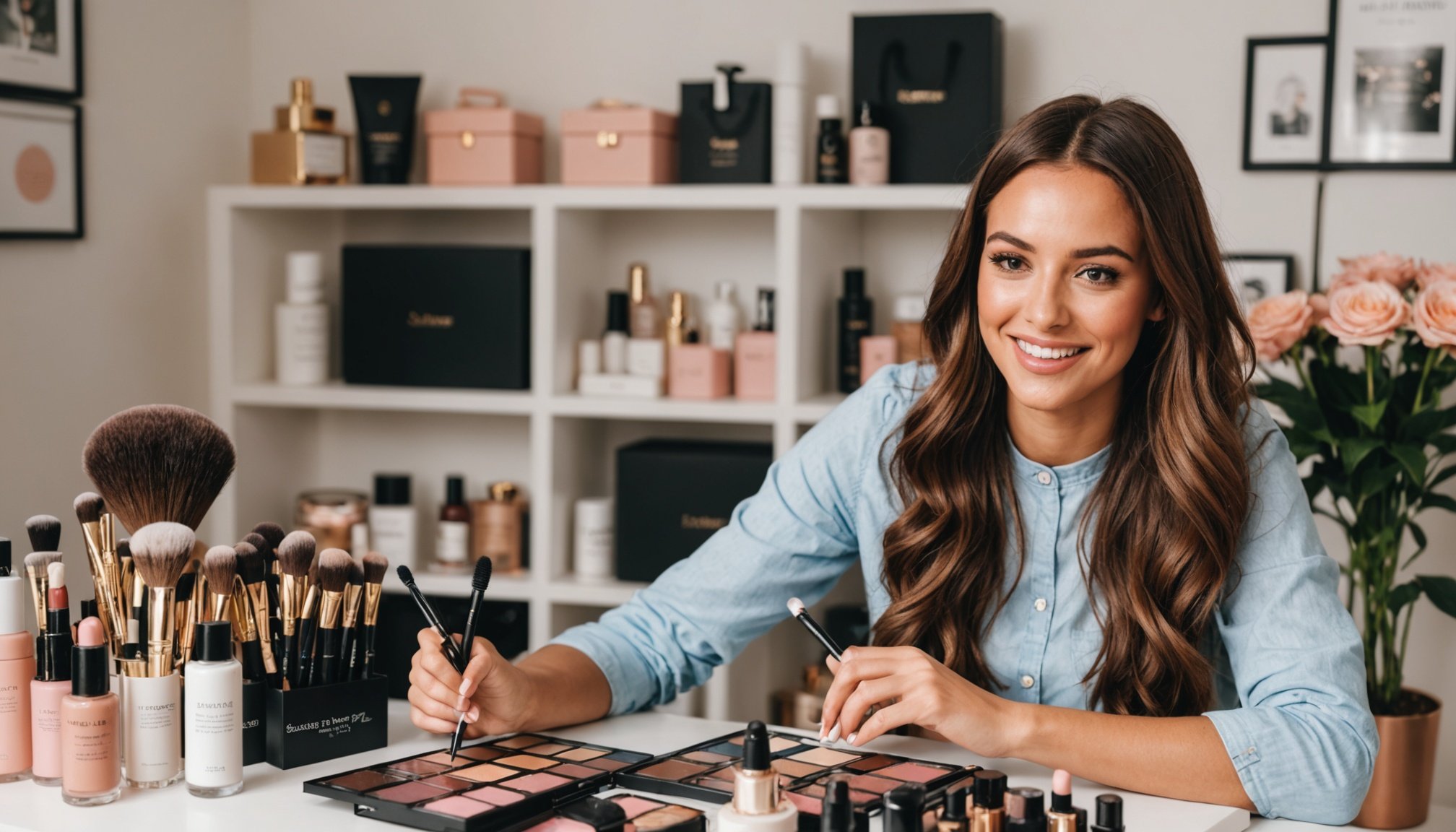Understanding Influencer Marketing for Beauty Brands
In the ever-evolving realm of beauty brands, influencer marketing has carved a significant niche. It’s not just about endorsing products; it’s a strategic tool that connects brands with their target audiences on a personal level. Influencer marketing in the UK market has become particularly influential, with an emphasis on genuine and impactful engagements.
Key Trends in UK Beauty Sector
The UK beauty industry is witnessing several trends reshaping influencer collaborations. Firstly, micro-influencers are gaining popularity due to their authentic connections with smaller, yet highly engaged, audiences. Secondly, there is a growing preference for video content, with beauty tutorials and product reviews on platforms like Instagram and TikTok being particularly effective.
Have you seen this : Crafting Impactful Remote Work Policies for UK Companies: A Comprehensive Guide
Authenticity and Brand Alignment
For a successful influencer partnership, authenticity and alignment with the brand’s ethos are crucial. Consumers are adept at discerning genuine endorsements from paid promotions. Therefore, influencers must resonate with the brand’s values and aesthetic to maintain credibility. When beauty brands in the UK market choose influencers who authentically use and appreciate their products, the trust they build with followers can lead to more substantial consumer loyalty and engagement. These collaborations go beyond mere marketing; they’re about creating a community of trust and relatability around the brand.
Defining Target Audience and Market Segmentation
Understanding your target audience is crucial in the dynamic beauty market of the UK. Identifying the specific demographics involves analyzing age, gender, and geographical distribution to uncover patterns within consumer behavior. For instance, younger audiences might lean towards bold and innovative beauty products, while older demographics may prefer established brands prioritizing skincare.
Also to discover : Crafting an Effective Digital Transformation Strategy for UK Family Businesses: A Step-by-Step Guide
Market segmentation plays a pivotal role in tailoring messages and products effectively. Segmenting audiences involves deciphering the needs and preferences of distinct consumer groups. In the beauty sector, this can include distinguishing between eco-conscious consumers and traditional beauty enthusiasts. Recognising these segments allows brands to hone their strategies and allocate resources more efficiently.
Analyzing consumer behavior uncovers what drives buying decisions. Preferences such as a trend towards organic ingredients or cruelty-free certifications highlight changing landscapes in consumer priorities. Brands can harness these insights to refine product offerings, thus resonating more deeply with their target audience.
Strategically segmenting the audience aids in developing targeted influencer campaigns that resonate well with specific consumer groups. By aligning influencers with segmented target demographics, brands can achieve higher engagement rates. This precision in marketing not only amplifies reach but also fosters a sense of authenticity and relatability among consumers.
Selecting the Right Influencers
Choosing the perfect influencers is essential for any successful marketing campaign. When it comes to influencer selection, several criteria ensure that the partnership aligns with your brand values and effectively reaches your target audience. Prioritize alignment with brand messaging by reviewing the influencer’s content style and values, their authenticity, and their connection with the audience.
As the influencer landscape diversifies, the choice between micro-influencers and macro-influencers becomes more crucial. Collaborating with micro-influencers, who generally have followers ranging from 1,000 to 100,000, offers unique advantages. Their content often boasts a higher engagement rate due to a more niche and actively participating audience. Compared to macro-influencers, they provide more targeted reach, often resulting in better customer engagement and trust.
In the digital age, several tools and platforms assist in influencer discovery and analysis. Platforms like Aspire and Traackr offer insights into follower demographics, engagement statistics, and historical performance. These tools can confidently guide choices by ensuring the influencer’s audience aligns perfectly with the campaign goals. Ultimately, well-informed decisions in influencer marketing can significantly boost brand visibility and credibility in a highly competitive market.
Developing a Compelling Campaign Strategy
In the beauty industry, devising a successful campaign strategy begins with understanding both the influencer and the audience. A pivotal element is aligning the campaign goals with the influencer’s capabilities and audience interests. This alignment creates authenticity, making the campaign more relatable and persuasive.
Collaborative content creation takes center stage in producing engaging influencer marketing campaigns. By partnering with influencers who resonate with your target audience, brands can tap into existing relationships and trust. Influencers often understand how to engage their followers better than anyone else, allowing brands to craft content that is both impactful and genuine.
Engagement is maximised when the content produced through collaborative projects reflects authenticity and creativity. Think of Instagram takeovers, exclusive behind-the-scenes content, or tutorials that let audiences engage directly with the influencer. These strategies not only showcase the influencer’s personality but also highlight the brand’s identity in a seamless manner.
To build an indelible bond with the audience, it’s crucial to consider the influencer’s unique style and delivery. Such a campaign strategy encourages influencers to stay true to themselves while promoting the brand. Ultimately, this approach ensures the campaign garners attention and fosters a strong connection between the brand and its potential customers.
Legal and Ethical Considerations
Navigating legal compliance in influencer marketing within the UK requires a solid understanding of regulations. It’s crucial to follow the guidelines set by the Advertising Standards Authority (ASA) and the Competition and Markets Authority (CMA). These guidelines mandate that all promotional content must be clearly marked, ensuring that audiences can readily distinguish between organic content and advertisements. This transparency is not merely an ethical obligation but a legal one, intended to maintain trust between influencers and their followers.
Proper disclosures are vital. Influencers must use clear language such as “ad” or “sponsored” to signify paid promotions. This transparency aids in meeting legal compliance and upholding ethical standards. When brands and influencers fail to disclose properly, they risk financial penalties and damage to their reputation.
Potential pitfalls include non-compliance with these guidelines, which can lead to legal action. It is advisable to regularly review legal requirements and updates from regulatory bodies. Mitigating legal risks involves proactive measures like consistent audits of influencer agreements and ensuring all parties are aware of their obligations. By adhering to legal and ethical considerations, brands protect themselves and build a genuine connection with their audience.
Budget Allocation and Financial Planning
Understanding how to effectively allocate your budget in influencer marketing is crucial for a successful campaign. The amount you allocate is often determined by the influencer’s tier and the overall scope of the campaign. For example, partnering with top-tier influencers typically requires a significant investment but can reach a wider audience, enhancing the campaign’s impact.
Conducting a thorough cost analysis of various marketing tactics across different platforms is essential. Platforms like Instagram and TikTok have distinct pricing models and audience reach, influencing your budget decisions. You might find that micro-influencers on TikTok offer a better value than mid-tier influencers on Instagram, depending on your target demographic.
To ensure you are getting the most out of your investment, implementing methods to measure return on investment (ROI) is critical. Calculate ROI by comparing the net profit from the campaign against the costs involved. Key performance indicators such as engagement rates, conversion rates, and sales attributed to influencer efforts can provide a comprehensive view of ROI. In essence, a well-planned budget allocation coupled with precise ROI measurement helps optimise your financial resources, ensuring every pound spent contributes effectively to your marketing objectives.
Measuring Campaign Success and Engagement Metrics
Understanding Engagement Metrics is crucial for evaluating the success of an influencer marketing campaign. These metrics help marketers determine how the audience interacts with the content. The main goal is to track Key Performance Indicators (KPIs) such as reach, impressions, likes, shares, comments, and conversion rates. Monitoring these indicators offers deep insights into the campaign’s effectiveness.
An array of tools is available to facilitate Performance Analysis. Platforms like Google Analytics, Hootsuite, or Instagram Insights provide detailed analytics on user behavior and engagement. These tools help marketers assess which content resonates best with the audience, allowing them to make informed decisions.
Effective use of KPIs enables brands to pinpoint successful elements within the campaign. For instance, a high conversion rate indicates good content-to-action alignment. On the other hand, engagement metrics like comments or shares can highlight areas needing improvement.
Learning from data insights is invaluable. By analysing engagement metrics and performance analysis, marketers can refine future campaigns. Identifying trends and patterns ensures that future strategies are not only well-informed but also tailored to achieve even greater success. This iterative approach drives continuous improvement in influencer marketing efforts, ensuring campaigns are engaging and effective over time.
Trends and Future of Influencer Marketing in the UK
In the beauty industry, influencer marketing has become a staple strategy, yet it’s an ever-evolving landscape. Current industry trends point towards a growing emphasis on authenticity and niche specialization. Consumers now favour influencers who demonstrate genuine use and enthusiasm for products, rather than those perceived as mere salespeople. This shift is reshaping the influencer space, pushing brands to seek out those with smaller, yet more engaged followings.
Future Predictions: Influencer Evolution
Looking ahead, the future of influencer marketing will likely involve greater adaptation to emerging social media platforms and evolving audience preferences. As new platforms rise to prominence, influencers must pivot to maintain relevance and connect with their target demographics. This adaptability will be vital for both seasoned influencers and brands attempting to engage effectively with audiences.
Moreover, video content is expected to dominate influencer marketing strategies, with platforms like TikTok and Instagram driving this trend. The evolution towards short-form, engaging content reflects changes in consumer behavior, requiring influencers and brands alike to continually innovate.
Ultimately, success in the influencer market will demand ongoing adaptation to both technological advancements and fundamental shifts in consumer behaviour. Brands that prioritize genuine connections and flexibility will thrive in this evolving field.











